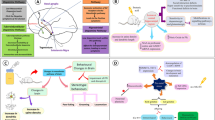Abstract
Neonatal lesions of the ventral hippocampus in rats lead to post- but not pre-pubertal behavioural changes suggesting adolescent onset of dopaninergic hypersensitivity and providing an animal model of schizophrenia. Neonatal exposure to glutamate receptor antogonists produces accelerated apoptosis leading to neuronal loss in central nervous system structures including the hippocampus. This suggested that neonatal MK-081 might lead to behavioural changes like those reported following ventral hippocampal lesions. Thus, rats received MK-801 (0, 0.5, 1.0 mg/kg, i.p.) on post-natal day 3 (P3) and were tested pre- (P35) and post-pubertally (P56). MK-801 produced an increase in TUNEL staining in the hippocampus and other forebrain structures, confirming the induction of apoptosis. Results showed little difference in locomotor activity between neonatal saline-and MK-801-treated groups during habituation or following saline injection but increased activity was seen in the 0.5 mg/kg MK-801 group following amphetamine (1.5 mg/kg, i.p.) at P35 but not P56. In test of pre-pulse inhibition (PPI), neonatal saline and MK-801 groups showed stable startle amplitudes, minimal responding to the pre-pulse stimuli alone, an increase in PPI with increases in pre-pulse intensity, and reduced PPI with apomorphine (0.1 mg/kg, s.c.). At P56, neonatal MK-801 groups tested following vehicle showed less sensitivity to changes in pre-pulse intensity. It was concluded that neonatal MK-801 increases apoptotic cell loss in the hippocampus but does not produce behavioural effects like those seen after neonatal ventral hippocampal lesions. However, neonatal MK-801 did lead to increases in locomotor activity in juveniles but not adults and reduced sensitivity to pre-pulse intensity in PPI tests in adulthood.
Similar content being viewed by others
References
Bayer, S.A. (1980) “Development of the hippocampal formation in the rat. I. Neurogenesis examined with 3H-thymidine autoradiography”, J. Comp. Neurol. 190, 87–114.
Beninger, R.J., Cooper, T.A. and Mazurski, E.J. (1985) “Automating the measurement of locomotor activity”, Neurobehav. Toxicol. Teratol. 7, 79–85.
Bolino, F., Di Michele, V., Di Cicco, L., Manna, V., Daneluzzo, E. and Casacchia, M. (1994) “Sensorimotor gating and habituation evoked by electro-cutaneous stimulation in schizophrenics”, Biol. Psychiatry 36, 670–679.
Braff, D.L., Stone, C., Callaway, E., Geyer, M.A., Glick, I.D. and Bali, L. (1978) “Prestimulus effects on human startle relfex in normals and schizophrenics”, Psychophysiology 15, 339–343.
Braff, D.L., Grillon, C. and Geyer, M.A. (1992) “Gating and habituation of the startle reflex in schizophrenic patients”, Arch. Gen. Psychiatry 49, 205–215.
Csernansky, J.G. and Bardgett, M.E. (1998) “Limbic-cortical neuronal damage and the pathophysiology in schizophrenia”, Schizophr. Bull. 24, 231–248.
Davis, M., Mansbach, R.S., Swerdlow, N.R., Campeau, S., Braff, D.L. and Geyer, M.A. (1990) “Apomorphine disrupts the inhibition of acoustic startle induced by weak prepulses in rats”, Psychopharmacology 102, 1–4.
Gavrieli, Y., Sherman, Y. and Ben-Sasson, S.A. (1992) “Identification of programmed cell death in situ via specific labeling of nuclear DNA fragmentation”, J. Cell. Biol. 119, 493–501.
Hanlon, F.M. and Sutherland, R.J. (2000) “Changes in adult brain and behavior caused by neonatal limbic damage: implications for the etiology of schizophrenia”, Behav. Brain Res. 107, 71–84.
Ikonomidou, C., Bosch, F., Miksa, M., Bittigau, P., Vöckler, J.. Dikranian, K., Tenkova, T.I., Stefovska, V., Turski, L. and Olney, J.W. (1999) “Blockade of NMDA receptors and apoptotic neurodegeneration in the developing brain”, Science 283, 70–74.
Jones, P. and Done, D.J. (1997) “From birth to onset: a developmental perspective of schizophrenia in two national birth cohorts”, In: Keshavan, M.S. and Murray, R.M., eds, Neurodevelopment and Adult Psychopathology (Cambridge University Press, Cambridge), pp 119–136.
Kato, K., Shishido, T., Ono, M., Shishido, K., Kobayashi, M., Suzuki, H., Nabeshima, T., Furukawa, H. and Niwa, S. (2000) “Effects of phencyclidine on behavior and extracellular levels of dopamine and its metabolites in neonatal ventral hippocampal damaged rats”, Psychopharmacology 150, 163–169.
Li, L., Corngut, L.M., Frost, B.J. and Beninger, R.J. (1998) “Prepulse inhibition in the rat following unilateral focal lesions of the inferior colliculus: prepulse intensity functions”, Physiol. Behav. 65, 133–139.
Lipska, B.K. and Weinberger, D.R. (2000) “To model a psychiatric disorder in animals: schizophrenia as a reality test”, Neuropsychopharmacology 23, 223–239.
Lipska, B.K., Jaskiw, G.E. and Weinberger, D.R. (1993) “Postpubertal emergence of hyperresponsiveness to stress and to amphetamine after neonatal excitotoxic hippocampal damage: a potential animal model of schizophrenia”, Neuropsychopharmacology 9, 67–75.
Lipska, B.K., Swerdlow, N.R., Geyer, M.A., Jaskiw, G.E., Braff, D.L. and Weinberger, D.R. (1995) “Neonatal excitotoxic hippocampal damage in rats causes post-pubertal changes in prepulse inhibition of startle and its disruption by apomorphine”, Psychopharmacology 122, 35–43.
Pearce, I.A., Cambray-Deakin, M.A. and Burgoyne, R.D. (1987) “Glutamate acting on NMDA receptors stimulates neurite outgrowth from cerebellar granule cells”, FEBS Lett. 223, 143–147.
Pohl, D., Bittigau, P., Ishimaur, M.J., Stadthaus, D., Hübner, C., Olney, J.W., Turski, L. and Ikonomidou, C. (1999) “N-methyl-d-aspartate antagonists and apoptotic cell death triggered by head trauma in developing rat brain”, Proc. Natl Acad. Sci. USA 96, 2508–2513.
Powell, S.B. and Geyer, M.A. (2002) “Developmental markers of psychiatric disorders as identified by sensorimotor gating”, Neurotox. Res. 489–502.
Raedler, T.J., Knable, M.B. and Weinberger, D.R. (1998) “Schizophrenia as a developmental disorder of the cerebral cortex”, Curr. Opin. Neurobiol. 8, 157–161.
Segal, D.S. and Janowsky, D.S. (1978) “Psychostimulant-induced behavioral effects: possible models of schizophrenia”, In: Lipton, A.M., DiMascio, A. and Killam, K.F., eds, Psychopharmacology: A Generation of Progress (Raven Press, New York), pp 1113–1123.
Segal, D.S. and Kuczenski, R. (1994) “Behavioral pharmacology of amphetamine”, In: Cho, A.K. and Segal, D.A., eds, Amphetamine and Its Analgos: Pharmacology, Toxicology, and Abuse (Academic Press, San Diego), pp 115–150.
Walter, D.E. and Palya, W.L. (1988) “An inexpensive experiments controller for stand-alone applications or distributed processing networks”, Behav. Res. Meth.Instrum. Comput. 16, 125–143.
Weinberger, D.R. (1995) “Neurodevelopmental perspectives on schizophrenia”, In: Bloom, F.E. and Kupfer, D.J., eds, Psychopharmacology: The Fourth Generation of Progress (Raven Press, New York), pp. 1171–1183.
Author information
Authors and Affiliations
Corresponding author
Rights and permissions
About this article
Cite this article
Beninger, R.J., Jhamandas, A., Aujla, H. et al. Neonatal exposure to the glutamate receptor antagonist MK-801: Effects on locomotor activity and pre-pulse inhibition before and after sexual maturity in rats. neurotox res 4, 477–488 (2002). https://doi.org/10.1080/10298420290031414
Received:
Revised:
Accepted:
Issue Date:
DOI: https://doi.org/10.1080/10298420290031414




